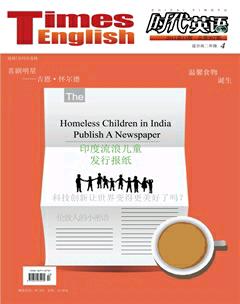科技创新让世界变得更美好了吗?
Every day, innovative companies promise to make the world a better place. Are they succeeding?
Here is just a sampling of the products, apps and services that have ever come across my radar:
A service that sends someone to fill your car with gas.
A service that sends a valet on a scooter to you, wherever you are, to park your car.
A service that will film anything you desire with a drone.
A service that will pack your suitcase — virtually.
A service that delivers a new toothbrush head to your mailbox every three months.
A service that delivers your beer right to your door.
A "smart" button and zipper that alerts you if your fly is down.
An app that lets us brew our coffee from anywhere.
A refrigerator advertised as "the Family Hub" that promises to act as a personal assistant, message board, stereo and photo album.
An app to locate rentable driveways for parking.
An app to help you understand "cause and effect in your life".
An app that imparts wisdom.
And a new proposal to create an app designed to stop police killings.
We are overloaded daily with new discoveries, patents and inventions all promising a better life, but that better life has not been forthcoming for most. In fact, the bulk of the above list targets a very specific (and tiny!) slice of the population. As one colleague in tech explained it to me recently, for most people working on such projects, the goal is basically to provide for themselves everything that their mothers no longer do.
He was joking — sort of — but his comment made me think hard about who is served by this stuff. Im concerned that such a focus on comfort and instant gratification will reduce us all to those characters in Wall-E, bound to their recliners, Big Gulps in hand, interacting with the world exclusively through their remotes.
When everything is characterized as “world-changing”, is anything?
Clay Tarver, a writer and producer for the painfully on-point HBO comedy Silicon Valley, said in a New Yorker article: "Ive been told that, at some of the big companies, the P.R. departments have ordered their employees to stop saying ‘Were making the world a better place, specifically because we have made fun of that phrase so mercilessly. So I guess, at the very least, were making the world a better place by making these people stop saying theyre making the world a better place.”
O.K., thats a start. But the impulse to conflate toothbrush delivery with Nobel Prize-worthy good works is not just a bit cultish, its currently a wildfire burning through the so-called innovation sector. Products and services are designed to “disrupt” market sectors (a.k.a.bringing to market things no one really needs) more than to solve actual problems, especially those problems experienced by what the writer C. Z. Nnaemeka has described as “the unexotic underclass” — single mothers, the rural poor, veterans, out-of-work people over 50 — who, she explains, have the “misfortune of being insufficiently interesting”.
If the most fundamental definition of design is to solve problems, why are so many people devoting so much energy to solving problems that dont really exist? How can we get more people to look beyond their own lived experience?
In Design: The Invention of Desire, a thoughtful and necessary new book by the designer and theorist Jessica Helfand, the author brings to light an amazing kernel: "hack", a term so beloved in Silicon Valley that its painted on the courtyard of the Facebook campus and is visible from planes flying overhead, is also prison slang for "horses ass carrying keys".
To "hack" is to cut, to gash, to break. It proceeds from the belief that nothing is worth saving, that everything needs fixing. But is that really the case? Are we fixing the right things? Are we breaking the wrong ones? Is it necessary to start from scratch every time?
Empathy, humility, compassion, conscience: these are the key ingredients missing in the pursuit of innovation, Ms. Helfand argues, and in her book she explores design, and by extension innovation, as an intrinsically human discipline — although one that seems to have lost its way. Ms. Helfand argues that innovation is now predicated less on creating and more on the undoing of the work of others.
"In this humility-poor environment, the idea of disruption appeals as a kind of subversive provocation", she writes. "Too many designers think they are innovating when they are merely breaking and entering."
In this way, innovation is very much mirroring the larger public discourse: unabashed confidence in ones own judgment shifts solutions away from fixing, repairing or improving and shoves them toward destruction for its own sake.
Perhaps the main reason these frivolous products and services frustrate me is because of their creators insistence that changing lives for the better is their reason for being.
Ms. Helfand calls for a deeper embrace of personal vigilance: "Design may provide the map", she writes, "but the moral compass that guides our personal choices resides permanently within us all".
Can we reset that moral compass? Maybe we can start by not being a bunch of hacks.
每一天,那些创新公司都在承诺着要让世界变得更美好。他们做到了吗?
下面是几个产品、手机应用和服务的例子,都是我曾注意到的。
让别人来帮你加满油的服务。
在任何地方叫代泊车服务员踩着滑板车来帮你停车的服务。
用无人机帮你为任何东西摄像的服务。
帮你收拾行李的服务 —— 虚拟的。
每三个月把新的牙刷头寄到你邮箱里的服务。
送啤酒上门的服务。
裤子拉链没拉上时会提醒你的“智能”纽扣和拉链。
在任何地点都可以煮咖啡的手机应用。
一种在广告宣传中被定义为“家庭中枢站”的冰箱,承诺充当私人助理、信息板、立体音响和相册。
寻找可供租用的私人停车位的手机应用。
帮你了解“人生因果”的手机应用。
传递智慧的手机应用。
最近还有人建议开发一种用来杜绝警察杀人的手机应用。
每一天,我们都被各种承诺要让生活更美好的新发现、新专利和新发明所淹没,但是对于大部分人来说,更美好的生活没有到来。其实在上面的单子里,大部分项目都是针对一个特定(而且很小!)的人群。最近一个科技领域的同事向我解释说,对于大多数研发这类项目的人来说,他们的目标基本上就是为自己提供各种妈妈不再为他们做的事情。
某种程度上,他是在开玩笑,但是他的话启发我去深入思考那些使用这些服务的人。我担心,这样关注方便舒适和即时的满足感,会把我们都变成《机器人瓦力》里的人,终日躺在躺椅上,拿着大杯饮料,只靠遥控器和世界互动。
当一切都被打上“改变世界”的标签,到底有什么东西能真正改变世界?
作家克莱·塔弗是一针见血的HBO喜剧《硅谷》的编剧。他在《纽约客》的一篇文章中说:“我被告知,在某些大公司里,公关部门要求雇员不要再说‘我们在让世界变得更美好这句话,主要是因为我们拿这句话开玩笑开得太狠了。所以至少我想,通过让这些人停止说‘我们让世界变得更美好,我们让世界变得更美好了。”
好吧,这是个开始。但是,把寄送牙刷和诺贝尔奖级别的杰作混为一谈的冲动,不只是一种宗教狂热,而是像燎原野火般横扫所谓的创新产业。很多产品和服务都旨在“扰乱”市场划分(换言之,就是把根本没人需要的东西推向市场),而不是用来解决真正的问题,尤其不能解决那些被作家C·Z·纳埃梅卡称之为“寻常的下层社会”所面临的问题 —— 就是那些单亲妈妈、乡村贫穷人、老兵、年过50的失业人 —— 她解释说,他们“很不幸,不够有趣”。
如果设计的最基本定义是用来解决问题,为什么那么多人投入那么多精力,去解决根本不存在的问题?我们该怎样让更多人看到超越自身生活体验之外的东西?
《设计:欲望的发明》是一本深思熟虑又非常有用的新书,作者是设计师兼理论家杰西卡·赫尔方。她解释了那个惊人的内核“骇客”,这个词为硅谷所深爱,被绘在Facebook园区的院子里,从飞机上都能看见。在监狱里,它是用来指代“狱警”的俚语。
做“骇客”就意味着切入、突击、打破。它源自那种没有任何事物值得保留,一切都需要被修理的信念。但是事实真的如此吗?我们是在修理需要修理的东西吗?我们是不是打破了不该打破的东西?每次都需要从零开始吗?
赫尔方指出,共情、谦卑、同情、良心,这些关键成分都是追求创新的过程中所缺失的。她在书中把设计,当然也包括创新,从本质上作为一个人文学科来探讨 —— 尽管这个学科似乎已经迷失了方向。赫尔方认为,如今,创新更多是基于毁掉别人的工作,而不是基于創造。
“在这样一个缺乏谦卑的环境下,‘扰乱的概念显得像是一种颠覆性的挑衅,”她写道,“太多的设计师觉得他们是在创新,其实他们只是在破坏和闯入。”
在这层意义上,创新成了一段更宏大的公共话语的缩影:对自我判断的自以为是,让解决方案偏离了修补、修正或改善的目的,变成了为破坏而破坏。
或许这些微不足道的产品与服务令我烦恼的主要原因,是因为它们的创造者坚持认为,它们的存在就是为了让生活变得更好。
赫尔方呼吁更多的个人警觉:“设计或许能够提供地图,”她写道,“但是能够指引个人选择的道德罗盘却永远存在于我们每个人的内心。”
我们能重新校准我们的道德罗盘吗?或许我们应该从不做骇客开始。
【词汇积累】
innovative adj. 革新的;创新的
mercilessly adv. 无情地;残忍地
impulse n. 冲动;一时的念头;推动力
humility n. 谦虚,谦逊
undo v. 消除,取消,废止(某事的影响)
vigilance n. 警觉;警惕;谨慎
vigilant adj. 警觉的;警戒的
colleague n. 同事,同僚
characterize v. 描述……的特征,描绘;
以……为特征
fundamental adi 根本的;基本的;必不可少的
by extension 自然地,当然地
discipline n. (大学里的)学科,科目
merely adv. 仅仅,只不过
permanently adv. 总是;持久地
bunch n. 一群,一伙(人等)

